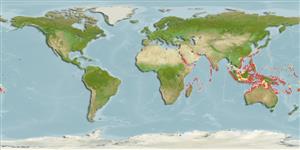Actinopterygii (ray-finned fishes) >
Perciformes (Perch-likes) >
Gobiidae (Gobies) > Gobiinae
Etymology: Amblyeleotris: Greek, amblys = darkness + The name of a Nile fish, eleotris (Ref. 45335).
Environment / Climate / Range
Ecology
Marine; reef-associated; depth range 5 - 35 m (Ref. 48637), usually 10 - 20 m (Ref. 27115). Tropical; 22°C - 28°C (Ref. 27115), preferred ?; 35°N - 23°S, 32°E - 174°W
Indo-West Pacific: Persian Gulf (Ref.80050) and Red Sea to Tonga, north to Japan and south to Australia.
Size / Weight / Age
Maturity: Lm ? range ? - ? cm
Max length : 11.0 cm SL male/unsexed; (Ref. 48637)
Dorsal
spines
(total): 7;
Dorsal
soft rays
(total): 12;
Anal
spines: 1;
Anal
soft rays: 12. Characterized by whitish body color; head and side with six brown to reddish bars and irregular brown blotches in pale spaces in between; four branched main body bars on lower side; red blotch on lower cheek just behind mouth; red or orange spots on head, dark-edged; separate pelvic fins, joined by low membrane at base of fins; without median predorsal scales or only few embedded scales just in front of first dorsal fin; longitudinal scale series 80-85; greatest depth of body 4.6-6.4 in SL; caudal fin longer than head, 2.8-3.4 in SL (Ref. 90102).
Inhabits coastal to outer reef sand slopes to 35 meters depth (Ref. 48637); on sandy areas of lagoon and seaward reefs (Ref. 9710). Inhabits burrows with alpheid shrimps (Ref. 11441).
Life cycle and mating behavior
Maturity | Reproduction | Spawning | Eggs | Fecundity | Larvae
Myers, R.F., 1991. Micronesian reef fishes. Second Ed. Coral Graphics, Barrigada, Guam. 298 p. (Ref. 1602)
IUCN Red List Status (Ref. 115185)
CITES (Ref. 94142)
Not Evaluated
Threat to humans
Harmless
Human uses
Aquarium: commercial
More information
Common namesSynonymsMetabolismPredatorsEcotoxicologyReproductionMaturitySpawningFecundityEggsEgg development
ReferencesAquacultureAquaculture profileStrainsGeneticsAllele frequenciesHeritabilityDiseasesProcessingMass conversion
Tools
Special reports
Download XML
Internet sources
Estimates of some properties based on models
Phylogenetic diversity index (Ref.
82805): PD
50 = 0.5000 [Uniqueness, from 0.5 = low to 2.0 = high].
Bayesian length-weight: a=0.00631 (0.00286 - 0.01390), b=3.08 (2.90 - 3.26), in cm Total Length, based on LWR estimates for this (Sub)family-body shape (Ref.
93245).
Trophic Level (Ref.
69278): 3.4 ±0.3 se; Based on size and trophs of closest relatives
Resilience (Ref.
69278): High, minimum population doubling time less than 15 months (Preliminary K or Fecundity.).
Vulnerability (Ref.
59153): Low to moderate vulnerability (27 of 100) .
